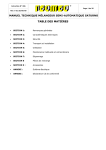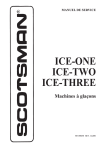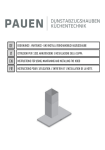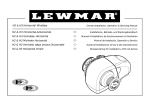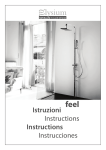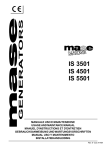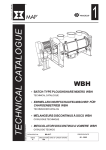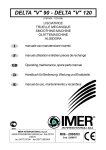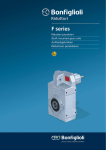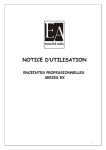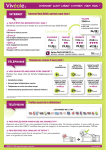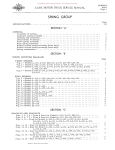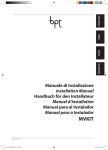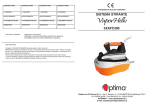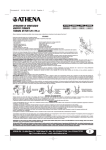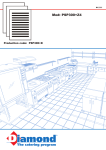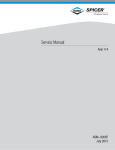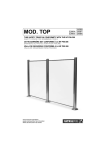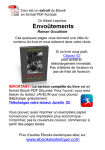Download IS 3501 IS 4501 IS 5501 - Mase Generators of North America
Transcript
mase GENERATORS IS 3501 IS 4501 IS 5501 MANUALE D'INSTALLAZIONE INSTALLATION MANUAL MANUEL D'INSTALLATION Rev. 0 -Cod. 41455 GENERATORS INDICE IL MANCATO RISPETTO DELLE SPECIFICHE CONTENUTE NEL SEGUENTE MANUALE DI INSTALLAZIONE, COMPORTA IL DECADIMENTO DELLA GARANZIA SUL PRODOTTO 1 INSTALLAZIONE 1.1 Caratteristiche del vano ...................................... 4 1.2 Ancoraggio del gruppo ....................................... 4 1.3 Ventilazione ....................................................... 4 2 CIRCUITO ACQUA DI RAFFREDAMENTO 2.1. Sistemi di adduzione dell'acqua di mare ............. 4 2.2 Tipica installazione con gruppo elettrogeno sopra la linea di galleggiamento ......................... 8 2.3. Tipica installazione con gruppo elettrogeno sotto la linea di galleggiamento .......................... 8 2.4. Componenti ...................................................... 10 2.5. Sistema di scarico ........................................... 12 3 CIRCUITO COMBUSTIBILE 3.0 Circuito combustibile ........................................ 12 4 4.1. 4.2. 4.3. 4.4. -2- COLLEGAMENTO ELETTRICI Allaciamento batteria ....................................... 14 Allacciamento cruscotto comandi .................... 14 Allacciamento c.a. ........................................... 16 Commutazione generatore - rete ...................... 18 IS 3501 - 4501- 5501 GENERATORS THE GUARANTEE OF THE PRODUCT BECOMES VOID IF THE SPECIFICATIONS CONTAINED IN THE FOLLOWING INSTALLATION MANUAL ARE NOT RESPECTED E1 INSTALLATION 1.1 Characteristics of the installation space ............. 5 1.2 Fastening the unit to the ground ......................... 5 1.3 Ventilation .......................................................... 5 2 COOLING WATER CIRCUIT 2.1. Sea water feed system ...................................... 5 2.2 Typical installation with electric generator above the water-line ............................................ 9 2.3. Typical installation with electric generator below the water-line ............................................ 9 2.4. Components .................................................... 11 2.5. Drainage system .............................................. 13 3 FUEL CIRCUIT 3.0 Fuel circuit ....................................................... 13 4 4.1. 4.2. 4.3. 4.4. IS 3501 - 4501- 5501 INDICE ELECTRICAL CONNECTION Battery connection ........................................... 15 Control panel connection .................................. 15 A.C. Connection ............................................... 17 Generator - Mains Switching ............................ 19 LE NON-RESPECT DES DIRECTIVES REPRISES DANS CE MANUEL D'INSTALLATION ENTRINE LA DECHEANCE DE LA GARANTIE SUR LE PRODUIT E1 INSTALLATION 1.1 Caracteristiques du local .................................... 5 1.2 Ancrage du groupe ............................................. 5 1.3 Ventilation .......................................................... 5 2 CIRCUIT D'EAU DE REFROIDISSEMENT 2.1. Système d'amenèe d'eau de mer ....................... 5 2.2 Installation typique avec groupe èlectrogène au dessus de la ligne de flottaison ..................... 9 2.3. Installation typique avec groupe èlectrogène sous la ligne de flottaison ................................... 9 2.4. Composants .................................................... 11 2.5. Système de purge ............................................ 13 3 CIRCUIT DU COMBUSTIBLE 3.0 Circuit du combustible ..................................... 13 4 CONNEXIONS ELECTRIQUES 4.1. Branchement de la batterie .............................. 15 4.2. Branchement du tableau de commande ........... 15 4.3. Raccordement c.a. ........................................... 17 4.4. Commutation gènèrateur-rèseau ...................... 19 -3 - GENERATORS 1.0. INSTALLAZIONE 1.1. Caratteristiche del vano IS 3501 - 4501- 5501 IS 3501 Il generatore deve essere installato in un locale sufficientemente aerato, in grado di assicurare la poca quantità d'aria necessaria alla combustione del motore. Il locale deve essere separato ed isolato acusticamente dalle aree abitabili. Il generatore va posizionato in modo da facilitare le normali operazioni di manutenzione. E' consigliabile l'installazione nel locale dei motori di propulsione a patto che questo sia conforme alle condizioni sopracitate. 1.2. Ancoraggio del gruppo Per il fissaggio del gruppo, predisporre un basamento per sopportare peso e vibrazioni. Procedere alla foratura del basamento seguendo le indicazioni di fig. 1 1.3. Ventilazione Il generatore è dotato di un sistema interno di raffreddamento forzato attraverso uno scambiatore acqua/aria. La quantità di aria necessaria alla combustione viene aspirata tramite l'apertura posta sul basamento (fig. 2): assicurarsi quindi che questa apertura sia sempre ben libera. IS4501 - 5501 2.0. CIRCUITO ACQUA DI RAFFREDDAMENTO Il motore viene raffreddato nel gruppo elettrogeno IS 2500 da un sistema a circuito aperto nel quale circola acqua di mare. La portata del circuito acqua mare è di 900 Lit/H (IS 2500) e 1200 Lit/H (IS 3500). All'atto dell'installazione è necessario predisporre un circuito di adduzione dell'acqua di mare per il raffreddamento e un sistema di scarico per la miscela di gas di combustione ed acqua. 2.1. Sistema di adduzione dell'acqua di mare Sulle imbarcazioni i sistemi normalmente adottati per l'immissione dell'acqua sono due (fig. 3). 1 - Sistema a presa diretta 2 - Sistema con deflettore Fig. 1 -4- IS 3501 - 4501- 5501 GENERATORS 1.0. INSTALLATION 1.0. INSTALLATION 1.1. Characteristics of the installation space 1.1. Caracteristiques du local The generator must be installed in a sufficiently aired space, supplying a little amount of air necessary for the combustion of the motor. The space must be separate and acoustically insulated from living areas. The generator should be positioned so that normal maintenance operations can easily be carried out. Propulsion motors are recommended for installation in the area as long as they comply with the above-mentioned conditions. Le gènèrateur doit ètre installè dans un local suffisamment aèrè, en mesure d'assurer la faible quantitè d'air à la combustion du moteur. Le local doit ètre sèparè et isolè du point de vue acoustique vis-à-vis des zones habitables. Le gènèrateur doit ètre positionnè de manière à faciliter les opèrations normales d'entretien. Nous conseillons l'installation dans le local des moteurs de propulsion à condition que ce local rèponde aux normes susmentionnèes. 1.2. 1.2. Fastening the unit to the ground To fasten the unit securely, a base should be installed to absorb vibrations and support the weight. Drill holes in the base according to the instructions in fig. 1. Pour la fixation du groupe, prèdisposer une embase pour supporter le poids et les vibrations. Rèaliser les orifices sur cette embase en respectant les indications de la figure 1. 1.3. 1.3. Ventilation The generator is equipped with an internal forced cooling system through a water/air exchanger. The air needed for combustion is taken in through the opening on the base (fig. 2) so care must be taken to ensure that this opening is always free. COOLING WATER CIRCUIT In electric generator IS 2500, the motor is cooled by an open-circuit system in which sea water circulates. The capacity of the sea water circuit is 900 Lit/H (IS 2500) and 1200 Lit/H (IS 3500). On installation a sea water feed circuit should be fitted for cooling and a waste system to expel the mixture of flue gas and water. La quantitè d'air nècessaire à la combustion est aspirèe à travers l'ouverture situèe sur l'embase (figure 2): s'assurer alors que cette ouverture est toujours bien libre. Sea water feed system CIRCUIT D'EAU DE REFROIDISSEMENT Le moteur est refroidi dans le groupe èlectrogène IS 2500 par un système à circuit ouvert dans lequel circule l'eau de mer. Le dèbit du circuit eau mer est de 900 Litres/heure (IS 2500) et 1200 Litres/heure (IS 3500). Il faut prèdisposer, lors de l'installation, un circuit d'amenèe d'eau de mer pour le refroidissement et un système d'èvacuation pour le mèlange de gaz de combustion et d'eau. 2.1. 2.1. Ventilation Le gènèrateur est muni d'un système interne de refroidissement forcè à travers un èchangeur eau/air. 2.0. 2.0. Ancrage du groupe Système d'amenèe d'eau de mer Boats usually use one of two systems to collect water (fig. 3): Les systèmes normalement adoptès sur les embarcations pour l'introduction de l'eau sont au nombre de deux (figure 3): 1 - Direct infeed system 2 - System with baffle 1 - système à prise directe 2 - système avec dèflecteur. -5 - IS 3501 - 4501- 5501 GENERATORS La MASE raccomanda il sistema a presa diretta rif. 1 fig. 3 in quanto questo sistema previene l'ingresso di acqua in pressione nei condotti di aspirazione, generando invece una depressione facilmente superabile dalla prevalenza della pompa acqua del gruppo elettrogeno. IMPORTANTE Non applicare nessun tipo di cuffia di protezione al sistema a presa diretta. IL SISTEMA A PRESA DIRETTA FORNITO DALLA DITTA MASE E' STATO MODIFICATO PER EVITARE A CORPI SOLIDI DI PENETRARE NELL'IMPIANTO INTASANDOLO. L'UTILIZZO DI ALTRI MATERIALI IN COMMERCIO COMPORTA UN'ATTENZIONE MAGGIORE E UNA PULIZIA PIU' FREQUENTE. Fig. 2 Il sistema con deflettore può invece causare i seguenti inconvenienti : a - Se viene montato con le asole rivolte verso la prua. In questo caso durante la navigazione e con gruppo elettrogeno spento si crea una pressione nel condotto immissione acqua, che può causare il riempimento dell'impianto, fino al raggiungimento delle luci di scarico rendendo così possibile l'ingresso di acqua nei cilindri. b - Se viene montato con le asole rivolte verso la poppa. In questo caso durante la navigazione si può creare una depressione nel condotto immissione acqua, tale da impedire alla pompa acqua di innescare l'impianto di raffreddamento o tale da limitare la portata con conseguente surriscaldamento del gruppo elettrogeno. -6- 1 2 Fig. 3 IS 3501 - 4501- 5501 GENERATORS MASE recommend the direct infeed system ref. 1 fig. 3 since this system prevents water under pressure entering the suction ducts and instead forms a pressure which can easily be overcome by the water pump of the electric generator. MASE recommande le système à prise directe rèf. 1 figure 3 car ce système prèvient l'entrèe de l'eau sous pression dans les conduites d'aspiration et engendre, au contraire, une dèpression qui peut facilement ètre corrigèe par la hauteur d'èlèvation de la pompe à eau du groupe èlectrogène. IMPORTANT IMPORTANT Do not apply any type of protective hood to the direct infeed system. N'appliquer acun type de coiffe de protection au système à prise directe THE DIRECT INFEED SYSTEM SUPPLIED BY MASE HAS BEEN MODIFIED TO PREVENT SOLID BODIES ENTERING THE SYSTEM AND BLOCKING IT. IF OTHER MATERIALS AVAILABLE ON THE MARKET ARE USED, MORE CARE AND MORE FREQUENT CLEANING IS NECESSARY. LE SYSTEME A PRISE DIRECTE LIVREE PAR LA SOCIETE MASE A ETE MODIFIE POUR EVITER QUE DES CORPS SOLIDES NE PENETRENT DANS L'INSTALLATION ET NE L'OBSTRUENT. L'UTILISATION DES AUTRES MATERIAUX COMMERCIALISES EXIGE UNE ATTENTION ACCRUE ET UN NETTOYAGE PLUS FREQUENT. The baffle system might cause the following problems: a - If it is installed with the slots facing the prow. In this case, during navigation and with the electric generator off, pressure is accumulated in the water infeed duct which might cause the system to fill up, even as far as the exhaust port, allowing water to enter the cylinders. b - If it is installed with the slots facing the stern. In this case a depression might accumulate in the water infeed duct during navigation, preventing the water pump from starting up the cooling plant, or limiting the capacity and subsequently causing the electric generator to overheat. Par contre le système avec dèflecteur peut causer les inconvènients suivants: a - s'il est montè avec les fentes tournèes vers l'avant. Dans ce cas, durant la navigation et avec le groupe èlectrogène èteint, une pression se crèe dans la conduite d'amenèe d'eau, d'ou un remplissage èventuel de l'installation jusqu'aux orifices de dècharge et l'entrèe possible de l'eau dans les cylindres. b - s'il est montè avec les fentes tournèes vers l'arrière. Dans ce cas, durant la navigation, une dèpression peut se former dans la conduite d'amenèe d'eau, au point d'empècher la pompe de l'eau d'enclencher l'installation de refroidissement ou au point de limiter le dèbit et donc de surchauffer le groupe èlectrogène. -7 - IS 3501 - 4501- 5501 GENERATORS 2.2. 1 2 3 4 5 6 7 8 9 Tipica installazione con gruppo elettrogeno sopra la linea di galleggiamento (fig. 4) Presa a mare Rubinetto presa acqua mare Rubinetto svuotamento impianto Filtro acqua Gruppo elettrogeno Marmitta Silenziatore Bocchettone scarico a mare Linea di galleggiamento Fig. 4 IMPORTANTE A - Tubazione diam. 45 mm. interno. B - Tubazione in gomma neoprene diam. 15 mm interno. C - Fascette di serraggio. ATTENZIONE E' molto importante rispettare le misure riportate in fig. 4-5 2.3. 1 2 3 4 5 6 7 8 9 10 11 12 13 Tipica installazione con gruppo elettrogeno sotto la linea di galleggiamento (fig. 5) Presa a mare Rubinetto genera impianto Rubinetto svuotamento impianto Filtro acqua Valvola antisifone Marmitta Silenziatore Bocchettone scarico a mare Linea di galleggiamento Drenaggio Miscelatore di scarico Pompa acqua Gruppo elettrogeno Fig. 5 -8- IS 3501 - 4501- 5501 GENERATORS 2.2. 1 2 3 4 5 6 7 8 9 Typical installation with electric generator above the water-line (fig. 4) 2.2. Sea intake • Prise en mer General tap-water • Robinet gènèral de l'eau Tap to drain system • Robinet de vidage de l'installation Water filter • Filtrè à eau Electric generator • Groupe èletrogène Muffler • Pot Silencer • Silencieux Sea drainage nozzle • Goult dècharge en mer Water line • Ligne de flottaison Fig. 4 IMPORTANT. IMPORTANT A - Tubes, internal diameter 45 mm B - Tubes, internal diameter 15 mm C - Clamps 2.3. CAUTION A - Tuyauterie d'un diamètre interne de 45 mm. B - Tuyauterie en caoutchouc Nèoprène d'un diamètre interne de 15 mm. C - Bagues de serrage. The measurements shown in fig. 4-5 should correspond exactly. ATTENTION Typical installation with electric generator below the water line (fig. 5) Il est très important de respecter les dimensions indiquèes sur les figures 4 et 5. 2.3. 1 2 3 4 5 6 7 8 9 10 11 12 13 Installation typique avec groupe èlectrogène au dessus de la ligne de flottaison (fig. 4). Sea intake • Prise en mer General tap-systemr • Robinet gènèral de l'eau Tap to drain system • Robinet de vidage de l'installation Water filter • Filtrè à eau Anti-siphon valve • Soupape antisiphon Muffler • Pot Silencer • Silencieux Sea drainage nozzle • Goult dècharge en mer Water line • Ligne de flottaison Drainage • Drainage Drain mixer • Mèlangeur de purge Water pump • Pompe à eau Electric generator • Goupe èletrogène Installation typique avec groupe èlectrogène sous la ligne de flottaison (fig. 5). Fig. 5 -9 - IS 3501 - 4501- 5501 GENERATORS 2.4. Componenti 1 - Presa a mare del tipo diretto 1/2". IMPORTANTE Nel caso il gruppo venga installato ad un altezza superiore ad 1 Mt. sopra la linea di galleggiamento, è necessario montare una valvola di non ritorno dopo la presa a mare (fig. 6 rif. 1) che impedisce lo svuotamento del circuito acqua a motore spento. In caso di svuotamento ,durante l'avviamento si può danneggiare la girante della pompa acqua; per lo stesso motivo all'atto del primo avviamento del gruppo, è necessario provvedere al riempimento manuale del tubo di aspirazione dalla valvola alla pompa. 1 Fig. 6 2 - Rubinetto a sfera (Generale impianto) 1/2". 3 - Rubinetto a sfera (Spurgo impianto) 1/2". Serve a vuotare l'impianto di raffreddamento del gruppo elettrogeno per manutenzioni generali o per periodi di lunga inattività. 4 - Filtro acqua (ispezionabile). Deve proteggere efficacemente il circuito di raffreddamento dall'ingresso di fango, sabbia e alghe. IMPORTANTE La rete filtrante dovrà essere del tipo fine. Si consiglia il tipo con passo 2 - 470 micron, misure diverse non consentirebbero un buon rendimento del filtro. Fig. 7 Anti-siphon valve Exhauste manifold Water pump 5 - Valvola antisifone: è una valvola che riporta a pressione atmosferica il circuito di raffreddamento a motore spento, evitando il fenomeno di sifonaggio. Va obbligatoriamente usata quando il generatore è installato col miscelatore di scarico sulla o sotto la linea di galleggiamento, e va posizionato ad almeno 50 cm. sopra il livello del mare. (vedi fig. 8/9). IMPORTANTE Il condotto di drenaggio della valvola antisifone deve obbligatoriamente viaggiare al di sotto della stessa impedendo così accumuli di acqua nel condotto, che deve rimanere sempre vuoto, per permettere il passaggio di aria nello stesso al momento dello spegnimento del gruppo ( vedi fig. 7). Fig. 8 N.B.: Si consiglia di portare il condotto di drenaggio in sentina perchè dallo stesso, durante il normale funzionamento, potrebbero fuoriuscire piccole quantità di acqua. La cassa è già predisposta con n° 2 fori per l'allacciamento della valvola antisifone (fig. 9). ANTI-SIPHON VALVE - 10 - Fig. 9 IS 3501 - 4501- 5501 GENERATORS 2.4. Components 2.4. 1 - Direct sea intake 1/2" IMPORTANT If the unit is installed more than 1 metre above the water-line, a check valve should be fitted after the sea intake (fig. 6, ref. 1) to prevent the water circuit emptying when the motor is off. If this empties, the rotor of the water pump might be damaged during start up; for the same reason, when the unit is first started up, the suction tube from the valve to the pump should be filled manually. 2 - Ball tap (general) 1/2" 3 - Ball tap (drainage) 1/2" This is used to drain the cooling system of the electric generator for general maintenance or when a long period of inactivity is expected. 4 - Water filter (can be inspected) This must provide efficient protection for the cooling circuit from the entrance of mud, sand and seaweed. IMPORTANT The filter mesh should be very fine. Mesh 2 - 470 micron is recommended, other sizes do not give good filter performance. 5 - Anti-siphon valve: this valve returns the cooling circuit to atmospheric pressure when the motor is switched off, to prevent the siphon phenomenon. It must be installed when the generator is fitted with the drainage mixer on or beneath the water line, and should be positioned at least 50 cm above water level.(see fig. 8/9) IMPORTANT The drainage duct of the anti-siphon valve must run beneath the valve itself in order to prevent water accumulating in the duct, which should always remain empty to allow air to pass through when the unit is switched off. (see fig. 7) N.B.: The drainage duct should be taken into the bilge because during normal operation small quantities of water might be leaked from the duct. The box already includes 2 holes to connect the anti-siphon valve (fig. 9). Composants 1 - Prise en mer, type direct 1/2". IMPORTANT Si le groupe est installèà une hauteur supèrieure à 1 mètre au dessus de la ligne de flottaison, il faut monter une soupape de non-retour après la prise en mer (figure 6, rèf. 1) qui empèche la vidange du circuit de l'eau lorsque le moteur est èteint. En cas de vidange, on peut endommager, durant le dèmarrage, la roue de la pompe à eau; c'est la raison pour laquelle il faut remplir manuellement le tube d'aspiration de la soupape à la pompe lors du premier dèmarrage du groupe. 2 - Robinet à bille (Caractèristiques gènèrales -Installation) 1/2". 3 - Robinet à bille (Purge de l'Installation) 1/2". Il sert à vider l'installation de refroidissement du groupe èlectrogène pour l'entretien gènèral ou pendant de longues pèriodes d'inactivitè. 4 - Filtre à eau (inspection possible). Il doit protèger efficacement le circuit de refroidissement en empèchant l'entrèe de la boue, du sable et des algues. IMPORTANT Le rèseau de filtrage doit correspondre au type fin. Nous conseillons le type avec pas 2 - 470 microns; des dimensions diffèrentes ne permettraient pas un bon rendement du filtre. 5 - Soupape anti-siphon: c'est une soupape qui reconduit à la pression atmosphèrique le circuit de refroidissement lorsque le moteur est èteint et permet d'èviter le phènomène de siphonnement. Elle doit ètre obligatoirement utilisèe lorsque le gènèrateur est installè avec le mèlangeur de purge sur ou sous la ligne de flottaison et elle doit ètre placèe à 50 cm au moins au dessus du niveau de la mer (se reporter aux figures 8 et 9). IMPORTANT La conduite de drainage de la soupape antisiphon doit obligatoirement passer au dessous de cette soupape, ce qui permet d'èviter l'accumulation de l'eau dans la conduite qui doit toujours ètre vide pour que l'air puisse passer lors de la dèsactivation du groupe (se reporter à la figure 7). NOTE: Nous conseillons de porter la conduite de drainage jusqu'à la sentine car de petites quantitès dèeau pourraient s'ècouler de cette conduite durant le fonctionnement normal. La caisse est dèjà prèdisposèe avec 2 orifices pour le raccordement de la soupape antisiphon (figure 9). -11 - IS 3501 - 4501- 5501 GENERATORS 2.5. Sistema di scarico Il sistema di scarico gas di combustione/acqua del generatore deve essere indipendente da quello dei motori principali. IMPORTANTE La lunghezza del tubo dal punto più alto del condotto di scarico alla marmitta non deve superare mt. 2. Questo per evitare che allo spegnimento del gruppo l'acqua rimasta nel condotto di scarico possa rifluire al motore dopo aver riempito la marmitta a barilotto. 1 - Marmitta a barilotto (capacità 3.5 litri). Attenua la rumorosità dello scarico ed impedisce il riflusso dell'acqua verso il motore. Si consiglia di installare la marmitta a non più di 1 mt. dal generatore e di posizionarla ad una altezza uguale o inferiore a quella del basamento del generatore. 2 - Silenziatore. Riduce ulteriormente la rumorosità. Si consiglia di installarlo ad una distanza non superiore ad 1 mt. dal bocchettone di scarico a mare. 3 - Bocchettone di scarico a mare. Va installato in posizione tale da essere sempre sopra il livello del mare. 3.0 CIRCUITO COMBUSTIBILE L'alimentazione del gruppo è a gasolio, ed avviene tramite i raccordi contrassegnati dalle diciture "GASOLIO" e "RITORNO GASOLIO" (fig.10, rif.1-2); quest'ultimo serve per il ritorno del combustibile in eccesso. Nel collegamento al serbatoio combustibile è necessario inserire un filtro combustibile;è inoltre buona norma inserire un rubinetto sulla linea di alimentazione a valle del serbatoio, ed una valvola unidirezionale (di non ritorno solo per dislivelli superiori a 50 cm) onde evitare lo svuotamento dell'impianto combustibile per qualsiasi causa. Utilizzare una valvola con apertura 50 millibar. I tubi del combustibile devono essere in gomma resistente agli idrocarburi, di diametro interno 6 mm. 1 2 IMPORTANTE Il gruppo è munito di spurgo nafta automatico. Qualora fosse necessario lo spurgo manuale premere il pulsante "ON" sul pannello comandi ed attendere 30 secondi prima di avviare il gruppo. IMPORTANTE Il filtro combustibile deve essere del tipo a cartuccia con grado di filtraggio da 5 a 10 micron. - 12 - 1 2 Diesel return Diesel Fig. 10 IS 3501 - 4501- 5501 GENERATORS The flue gas/water drainage system of the generator must be separate from that of the main motors 2.5. Système de purge Le système de purge du gaz de combustion/eau du gènèrateur doit ètre indèpendant de celui des moteurs principaux. IMPORTANT IMPORTANT The length of the tube from the highest point of the drain duct to the muffler should not exceed 2 metres. This is to prevent the water left in the drainage duct returning to the motor after filling the tank muffler, when the unit is turned off. La longueur du tube à partir du point le plus èlevè de la conduite de purge jusqu'au pot ne doit pas dèpasser 2 mètres. Cela permet d'èviter que l'eau qui stagne dans la conduite de purge au moment de la dèsactivation du groupe puisse refluer vers le moteur après avoir rempli le pot à barillet. 2.5. Drainage system 1 - Tank muffler (capacity 3.5 litres) This dampens the noise of the drainage and stops the water flowing back towards the motor. The muffler should be installed no less than 1 metre away from the generator and positioned at a height less than or equal to that of the base plate of the generator. 2 - Silencer This further reduces noise. It should be installed no more than 1 metre from the sea drainage nozzle. 3 - Sea drainage nozzle; It should be installed so that it is always above the water line. . 1 - Pot à barillet (contenance: 3.5 litres). Il attènue le bruit de la dècharge et empèche le reflux de l'eau vers le moteur. Nous conseillons d'installer le pot à une distance non supèrieure à 1 mètre du gènèrateur et de le positionner à une hauteur ègale ou infèrieure à celle du socle du gènèrateur. 2 - Silencieux. Il attènue le bruit. Nous conseillons de l'installer à une distance non supèrieure à 1 mètre du goulot de dècharge en mer. 3 - Goulot de dècharge en mer: il doit ètre installè dans une position qui lui permette d'ètre toujours au dessus du niveau de la mer. 3.0. 3.0. FUEL CIRCUIT The unit is fed by diesel fuel through the tubes marked “DIESEL” and “DIESEL RETURN” (fig. 10, ref. 1-2). This latter is used for the return of the excess fuel. It is necessary to install a filter in connections to the fuel tank, it is also advisable to fit a tap onto the power supply line downstream of the tank and a single-acting valve (check valve only for a difference in height of 50 cm or more) to prevent the fuel system emptying for any reason. Use a valve with a 50 millibar opening. The fuel pipes should be in hydrocarbon-resistant rubber, of inner diameter 6 mm. IMPORTANT The unit is fitted with automatic diesel oil drainage. If manual drainge is necessary, press the "ON" button and 30 second before set going the unit. IMPORTANT The fuel filter must be a "cartridge-type" with a filtering grade of 5 to 10 micron CIRCUIT DU COMBUSTIBLE L'alimentation du groupe, à gasoil, s'effectue par l'intermediaire des raccords portant les indications GASOIL et RETOUR DU GASOIL (figure 10 - rèf. 1-2); ce dernier sert pour le retour du combustible en excès. Il faut introduire, dans le raccordement au rèservoir du combustible, un filtre-combustible; il est de règle de placer un robinet sur la ligne d'alimentation en aval du rèservoir et une soupape unidirectionnelle (de non-retour uniquement pour les dènivellations supèrieures à 50 cm) pour èviter le vidage de l'installation de combustible, quelle que soit la cause. Utiliser une soupape avec une ouverture de 50 millibar. Les tubes du combustible, d'un diamètre interne de 6 mm, doivent ètre en caoutchouc rèsistant aux hydrocarbures. IMPORTANT Le groupe assure une purge automatique du mazout. Si la purge manuelle ètait nècessaire, presser le bouton ON sur le panneau des commandes et attendre 30 secondes avant d'activer le groupe. IMPORTANT Le filtre-combustible doit avoir les caractèristiques suivantes: type à cartouche, avec un degrè de filtration de 5 à 10 microns. -13 - IS 3501 - 4501- 5501 GENERATORS 4.0. COLLEGAMENTI ELETTRICI 4.1. Allacciamento batteria IS 2500 - 35000 Per l'avviamento del gruppo è necessario utilizzare una batteria indipendente a 12V, di capacità 18 - 30 Ah minimo Essa va allacciata al morsetto del generatore come da fig.11 con cavi di sez. 25 mm2 fino a distanze di 5 mt. con cavi di sez. 35 mm2 per distanze maggiori, rispettando questa sequenza di operazioni: - Collegare prima il polo positivo (+) della batteria al terminale contrassegnato dal simbolo (+) sul generatore. (MOTORINO D'AVVIAMENTO) - Collegare successivamente il polo negativo (-) della batteria al terminale contrassegnato dal simbolo (-) sul generatore. - Cospargere le connessioni con specifico grasso minerale, al fine di ridurre ossidazioni o corrosioni. Il generatore è dotato di un dispositivo elettronico per la ricarica automatica della batteria di avviamento, capace di erogare 10 A, ad una tensione di 12V, a pieno carico. IS 4500 Fig. 11 IMPORTANTE Installare la batteria in un vano aerato, separato dal generatore e da ogni dispositivo che possa provocare calore o scintille. Verificare periodicamente lo stato delle connessioni dei morsetti ed il livello acqua batteria. Nel caso si renda necessario scollegare i cavi, agire inversamente all'ordine raccomandato nel collegarli.Non invertire le polarità dei cavi di connessione; il generatore e la batteria potrebbero esserne seriamente danneggiati. Non collegare altri carichi alla batteria. Al fine di minimizzare le correnti galvaniche il (-) della batteria del gruppo elettrogeno non deve essere collegato al (-)delle altre batterie di bordo. 4.2. 1 2 3 Fig. 12 Allacciamento cruscotto comandi Questo collegamento è eseguibile tramite le morsettiere (fig. 12, rif.1 ) utilizzando i cavi in dotazione già collegati al cruscotto comandi; i morsetti da usare sono rispettivamente quelli contrassegnati dal n° 1 al n° 9 per i cavi comando. Le calze di massa vanno collegate al morsetto faston (fig. 12, rif. 2 ) isolandole accuratamente e utilizzando un fast-on femmina preisolato. Nei colleganenti è necessario rispettare lo schema codice/colore riportato di seguito (fig. 13). Bloccare inoltre il cavo con le fascette in dotazione all'apposito supporto plastico (fig. 12, rif. 3). Sul cruscotto comandi sono presenti 5 LED di funzionamento ed allarme (fig. 14, rif. 1 ), un contaore (fig.14, rif.2) Fig. 13 - 14 - IS 3501 - 4501- 5501 GENERATORS 4.0. ELECTRICAL CONNECTIONS 4.0. CONNEXIONS ELECTRIQUES 4.1. Battery connection 4.1. Branchement de la batterie To start off the unit an independent battery of 12V is needed, capacity 18 - 30 Ah min. It should be connected to the clamp of the generator as shown in fig. 11 with cables of section 25 mm2 up to distances of 5 metres and with cables of section 35 mm2 for longer distances, and following the sequence of operations described below: - First connect the positive pole (+) of the battery to the terminal marked with the symbol (+) on the generator, (the starter). Pour l'activation du groupe il faut utiliser une batterie indèpendante à 12 V, d'une puissance de 18 - 30 Ah au minimum. Elle doit ètre branchèe au plot du gènèrateur selon figure 11 avec des càbles d'une section de 25 mm2 jusqu'à des distances de 5 mètres et avec des càbles d'une section de 35 mm2 pour des distances supèrieures, en respectant cette sèquence d'opèrations: - Relier d'abord le pòle positif (+) de la batterie à la borne indiquèe par le symbole (+) sur le gènèrateur (DEMARREUR). - Then connect the negative pole (-) of the battery to the terminal marked with the symbol (-) on the generator. - Relier ensuite le pòle nègatif (-) de la batterie à la borne indiquèe par le symbole (-) sur le gènèrateur. - Wipe the connections with special mineral grease to protect against oxidation and corrosion. The generator includes an electronic device to automatically recharge the start-up battery, giving 10 A, at a voltage of 12 V, when fully charged. - Recouvrir les connexions de graisse minèrale pour rèduire les oxydations ou les corrosions. Le gènèrateur est muni d'un dispositif èlectronique pour la recharge automatique de la batterie de dèmarrage, capable de dèbiter 10 A, à une tension de 12 V, à pleine charge. IMPORTANT IMPORTANT Install the battery in a well-ventilated area, away from the generator and from any device which might produce heat or sparks. Periodically check the state of the connections of the terminals and the water level of the battery. If the cables need to be disconnected, follow the instructions for connection in reverse order. Do not invert the poles of the connecting cables since serious damage might be caused to the generator and the battery. Do not connect other loads to the battery. Installer la batterie dans un local aèrè, sèparè du gènèrateur et de tout dispositif qui puisse provoquer de la chaleur ou des ètincelles. Vèrifier pèriodiquement l'ètat des connexions des bornes et le niveau de l'eau de la batterie. Dans le cas o• il serait nècessaire de dèconnecter les càbles, respecter l'ordre inverse de celui qui avait ètè recommandè pour la connexion. Ne jamais inverser les polaritès des càbles de connexion; le gènèrateur et la batterie pourraient subir une dètèrioration. Ne jamais connecter d'autres charges à la batterie. In order to reduce galvanic currents to a minimum, the () of the battery of the electric generator should not be connected to the (-) of the other batteries on board. 4.2. Control panel connection This connection can be made through the terminal boards (fig. 12, ref. 1) using the cables provided already connected to the control panel. The terminals to be used are those marked no. 1 to no. 9 for the control cables. The earths braid should be connected to the faston terminal (fig. 12, ref. 2) insulating them carefully and using a pre-insulated female faston. In making the connections it is important to follow the diagram and the colours codes as indicate (fig. 13). Fasten the cable with the provided plastic support on the bail (fig. 12, ref. 3). The control panel contains 5 LEDs for operation and alarm (fig. 14, ref. 1), an hour counter (fig. 14, ref. 2) and the start and stop buttons (fig. 14, ref. 3/4/5). For fixing the control panel is necessary to perforate as shown in fig.14. En vue de minimiser les courants galvaniques le (-) de la batterie du groupe èlectrogène ne doit pas ètre reliè au () des autres batteries du bord. 4.2. Branchement du tableau de commande Ce branchement est rèalisable gràce aux borniers (figure 12 - rèf. 1), en utilisant les càbles en dotation, dèjà reliès au tableau de commande; les bornes à utiliser sont respectivement celles qui correspondent aux numèros de 1 à 9 pour les càbles de commande. Les conducteurs èlectriques de terre à tresse doivent ètre reliès à la borne faston (figure 12 - rèf. 2), après avoir ètè soigneusement isolès et en utilisant un faston femelle prè-isolè. Les connexions doivent respecter le schèma code/couleur indiquè ci-après (figure 13). Bloquer enfin le càble avec les bagues en dotation sur le support plastique appropriè (figure 12 - rèf. 3). Sur le tableau de commande se trouvent 5 LED de fonctionnement et d'alarme (figure 14 - rèf.1), un compteur horaire (figure 14 - rèf. 2) et les boutons-poussoirs de -15 - IS 3501 - 4501- 5501 GENERATORS ed i pulsanti di avviamento ed arresto (fig. 14, rif.3/4/5). Per fissare il cruscotto comandi occorre eseguire una foratora come da fig. 14. IMPORTANTE Il cruscotto comandi và necessariamente installato, in quanto esso è indispensabile per il funzionamento del gruppo: non utilizzare dispositivi diversi dal comando fornito col gruppo, poichè essi potrebbero non essere compatibili con il generatore stesso. Eseguire l'allacciamento a batteria scollegata. 2 5 4 3 1 ATTENZIONE Fig. 14 Il cruscotto comandi viene fornito con un cavo di collegamento lungo 10 metri. E' importante che questo cavo non venga modificato, questo potrebbe causare un funzionamento improprio del circuito del cruscotto. 4.3. Allacciamento c.a. 1 Questo collegamento é eseguibile tramite la morsettiera di potenza (fig. 15, rif. 1). Questa gamma prevede la possibilità di un utilizzo sia a 110 V 50 Hz - 120 V 60Hz che a 220 V 50 Hz - 240 V 60 Hz. Sono perciò possibili due tipi di collegamenti (e quindi di utilizzo), secondo le seguenti configurazioni. 1 - Collegamento in parallelo : in questa configurazione si ha una unica uscita a 110 (120) V fra i punti P1 e F2, collegando le uscite dell'alternatore (P1,F1,P2,F2) secondo lo schema di fig. 16. Fig. 15 2 - Collegamento in serie : in questa configurazione è possibile prelevare potenza a tensione 220 (240) V fra i punti P1 e F2, come lo schema di fig. 17. Nel collegamento in serie è possibile prelevare contemporaneamente la potenza sia a tensione 110 (120) V fra i punti F1-F2 e P1-P2 che a tensione 220 (240) V fra i punti P1 e F2, come da schema di fig. 18. E' possibile inoltre alimentare due linee separate come da fig. 19 sulle uscite P1-F1 e P2-F2. Fig. 16 N.B.: In questo caso la potenza prelevabile da ognuna delle due uscite è la metà di quella nominale di targa. Fig. 17 - 16 - IS 3501 - 4501- 5501 GENERATORS IMPORTANT The control panel is indispensable for operating the unit and must be installed; do not use devices othet than the control panel supplied with the unit since they might not be compatible with the generator. Make the connections with the battery disconnected. CAUTION The control panel is provided with a connecting cable 10 metres long. This cable should not be modified since it might cause the panel circuit to function incorrectly. 4.3. A.C. Connection This connection can be done through the power terminal board (fig. 15, ref. 1) placed inside the derivation box. This range includes the possibility of use both at 110V 50Hz - 120V 60Hz and 220V 50Hz - 240V 60Hz. For this reason it is possible to make two types of connection (and use), according to the following configurations. 1 - Parallel configuration: in this configuration there is a single output at 110 (120) V between points P1 and F2, connecting the outputs of the alternator (P1, F1, P2, F2) as shown in the diagram in fig. 16. 2 - Serial connection; in this configuration it is possible to use a voltage of 220 (240) V between points P1 and F2, as shown in the diagram in fig. 17. In serial connection, power can be picked up both at 110 (120) V between points F1 - F2 and P1 - P2 and at 220 (240) V between points P1 and F2 at the same time, as shown in the diagram in fig. 18. It is also possible to feed two separate lines as shown in fig. 19 on the outputs P1- F1 and P2- F2. N.B. In this case the power which can be taken from each of the two outputs is half the rated nominal power. dèmarrage et d'arrèt (figure 14 - rèf. 3/4/5). Pour fixer le tableau de commande, rèaliser un orifice selon Figure 14. IMPORTANT Le tableau de commande doit ètre nècessairement installè car il est indispensable pour le fonctionnement du groupe: ne pas utiliser d'autres dispositifs, diffèrents de la commande livrèe avec le groupe, car ils pourraient ne pas ètre compatibles avec le gènèrateur. Brancher après avoir dèconnectè la batterie. ATTENTION Le tableau de commande est livrè avec un càble de liaison de 10 mètres. Il est important que ce càble ne soit pas modifiè; il pourrait en dèriver un fonctionnement inadèquat du circuit du tableau de commande. 4.3. Raccordement c.a. Ce raccordement est rèalisable gràce au bornier de puissance (figure 15, rèf.1). Cette gamme prèvoit la possibilitè d'une utilisation aussi bien à 110 V 50 Hz - 120 V 60 Hz qu'à 220 V 50 Hz - 240 V 60 Hz. Deux types de raccordements (et donc d'utilisation) sont par consèquent possibles selon les configurations suivantes: 1 - Liaison en parallèle: dans cette configuration nous avons une seule sortie à 110 (120) V entre les points P1 et F2, en reliant les sorties de l'alternateur (P1, F1, P2, F2) selon le schèma de la figure 16. 2 - Liaison en sèrie: dans cette configuration on peut prèlever la puissance à une tension 220 (240) V entre les points P1 et F2 selon le schàma de la figure 17. Dans la liaison en sèrie on peut pr_lever simultanèment la puissance à une tension de 110 (120) V entre les points F1-F2 et P1-P2 qu'à une tension de 220 (240) V entre les points P1 et F2, selon le schèma de la figure 18. On peut en outre alimenter deux lignes sèparèes selon la figure 19 sur les sorties P1-F1 et P2-F2. NOTE: Dans ce cas la puissance que l'on peut prèlever de chacune des deux sorties est la moitiè de celle nominale figurant sur la plaque. -17 - IS 3501 - 4501- 5501 GENERATORS - Assicurarsi che la somma dei carichi da alimentare non superi la potenzanominale del gruppo elettrogeno. - Si raccomanda di interporre fra generatore e utenze elettriche protezioni magnetotermiche o similari, secondo le tabelle di seguito riportate. - Per ottenere i collegamenti sia in parallelo che in serie utilizzare sulla morsettiera fig. 15 rif. 1 gli appositi ponticelli dati in dotazione negli accessori del gruppo elettrogeno. Distribuzione a tensione unica Fig. 18 IS 3501 TAB 1 Hz V W. A 50 110 2700 24.5 60 120 2900 24.2 50 220 2700 12.3 60 240 2900 12.1 CARICO LOAD CHARGE IS 4501 - 5501 Hz V W. A 50 110 4000 36.5 60 120 4800 40 50 220 4000 18 60 240 4800 20 CARICO LOAD CHARGE Fig. 19 NB. In questi casi va installato un solo magnetotermico, vedi fig. 16/17. RETE MAINS RESEAU Distribuzione a tensione doppia (Tab. 2) Hz V W A IS 3501 50 110/220 2700 12.3 Hz V W A 60 120/240 2900 12.1 IS 4501 - 5501 50 110/220 4000 18 60 120/240 4800 20 NB. In questi casi vanno installati due magnetotermici, vedi fig. 18/19, dimensionati sui valori di corrente (A) riportati in Tab. 2 4.4. Commutazione generatore - rete E' necessario interporre sulla linea di utilizzo un commutatore che permetta di commutare le utenze dal generatore ad una linea di alimentazione esterna. Il commutatore va dimensionato in base all'entità dei carichi in gioco; uno schema di massima è rappresentato in fig. 20. - 18 - CARICO LOAD CHARGE Fig. 20 IS 3501 - 4501- 5501 GENERATORS - Ensure that the sum of the loads to be supplied does not exceed the nominal power of the electric generator. - Magnetothermic protective devices or similar should be placed between the generator and electrical equipment, according to the tables shown below. - To make both parallel and serial connections, use the special bridges provided in the accessories to the electric generator on the terminal board fig. 15 ref. 1. Single voltage distribution - S'assurer que la somme des charges à alimenter ne soit pas supèrieure à la puissance nominale du groupe èlectrogène. - Nous recommandons de placer, entre le gènèrateur et les applications èlectriques, des protections magnètothermiques ou similaires, selon les tableaux que nous reportons ci-après. - Pour obtenir des liaisons aussi bien en parallèle qu'en sèrie utiliser sur le bornier figure 15 - rèf. 1 les barrettes approprièes, livrèes avec les accessoires du groupe èlectrogène. Distribution à tension unique IS 3501 TAB 1 Hz V W. A 50 110 2700 24.5 60 120 2900 24.2 IS 3501 50 220 2700 12.3 60 240 2900 12.1 TAB 1 Hz V W. A 50 110 2700 24.5 IS 4501 - 5501 Hz V W. A 50 110 4000 36.5 60 120 4800 40 50 220 4000 18 60 120 2900 24.2 50 220 2700 12.3 60 240 2900 12.1 IS 4501 - 5501 60 240 4800 20 Hz V W. A 50 110 4000 36.5 60 120 4800 40 50 220 4000 18 60 240 4800 20 N.B: In these cases just one magnetothermic device should be installed, see fig. 16/17. NOTE: Un seul magnètothermique doit ètre installè dans ce cas (se reporter à la figure 16/17). Double voltage distribution Distribution à tension double Hz V W A IS 3501 50 110/220 2700 12.3 Hz V W A 60 120/240 2900 12.1 IS 4501 - 5501 50 110/220 4000 18 60 120/240 4800 20 N.B: In these cases two magnetothermic devices should be installed, see fig. 18/19, dimensioned on the current values (A) shown in Table. 2. 4.4. Generator - Mains switching A switch should be placed on the line to switch the user appliances from the generator to an external power line. The switch should be dimensioned according to the size of the loads: a general diagram is shown in fig. 20. Hz V W A IS 3501 50 110/220 2700 12.3 Hz V W A 60 120/240 2900 12.1 IS 4501 - 5501 50 110/220 4000 18 60 120/240 4800 20 NOTE: deux magnètothermiques doivent ètre installès dans ces cas (se reporter à la figure 18/19), dimensionnès sur les valeurs du courant (A) reprises sur le tableau 2. 4.4. Commutation gènèrateur - rèseau Il faut interposer sur la ligne d'utilisation un commutateur qui permette de commuter les applications du gènèrateur à une ligne d'alimentation externe. Le commutateur doit ètre dimensionnè sur la base de l'entitè des charges en jeu; un schèma d'ensemble est fourni par la figure 20. -19 - Mase Generators S.p.a. • Via Tortona, 345 • 47023 Cesena (FC) ITALY • Tel. (+39) 0547.35.43.11 Fax (+39) 0547.31.75.55 • www.masegenerators.com • e-mail [email protected]




















